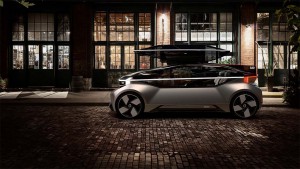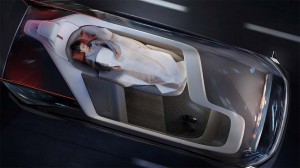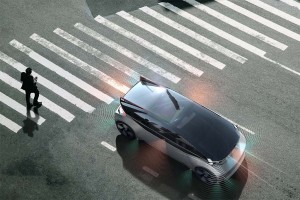Flying is glamorous, or so the airlines would have you believe, but ask anyone who has had to deal with security lines, crowded cabins and inevitable delays and you’ll get an entirely different picture.
That’s where something like the Volvo 360c might offer a pleasant alternative. While the industry has focused on using driverless vehicles to replace conventional taxicabs, the self-driving concept from Volvo has long-distance travelers in mind. Billed as “the future of autonomous travel,” the 360c is designed to skip the lines and deliver the sort of experience you might expect flying on a private jet.
“Domestic air travel sounds great when you buy your ticket, but it really isn’t,” said Mårten Levenstam, senior vice president of corporate strategy at Volvo Cars, adding that “The 360c represents what could be a whole new take on the industry.”
The heart of the concept, Levenstam explains, is “The sleeping cabin (which) allows you to enjoy premium comfort and peaceful travel through the night and wake up refreshed at your destination. It could enable us to compete with the world’s leading aircraft makers.”

The 360c could be configured for long-distance travel or to let a commuter work on the way to the office.
(Fiat Chrysler launches new autonomous vehicle testing center. Click Here for the full story.)
The 360c actually brings together two key technologies expected to transform the automotive world: it is not only completely autonomous but fully electric. Volvo isn’t offering details about the drivetrain on the concept, though it notes that it sees “shorter routes (of) around 300 kilometers (as) prime candidates for disruption by an alternative mode of travel.” That works out to around 190 miles, something easily met by today’s latest all-electric vehicles. The Tesla Model S P100D can top 300 miles and some manufacturers are now talking about taking range up to 400 miles or more.
Meanwhile, by eliminating the need for a driver, car designers are rethinking the basic way a vehicle can be laid out inside. The Mercedes-Benz F 015 concept of a few years back featured swiveling seats that, when operating in autonomous mode, could be turned around to create a living room-style cabin. By placing the batteries, motors and key electronic components under the floor, Jaguar recaptured some of the space normally devoted to the engine compartment, giving its new I-Pace electric SUV a cabin significantly roomier than its compact exterior would suggest.
With the Volvo 360c, the Swedish automaker envisions a multitude of ways the interior can be configured. On long routes, it can turn into that rolling bedroom. Around town, use it as a mobile office, living room or an entertainment space.
“Autonomous vehicle concepts have a tendency to become a technology showcase instead of a vision of how people use it,” said Robin Page, senior vice president of design at Volvo Cars. “But Volvo is a human-centric brand. We focus on the daily lives of our customers and how we can make them better. The 360c is the next iteration of this approach.”
(Apple’s autonomous vehicle involved in crash. Click Here to see who was at fault.)
While the 360c is clearly a concept – the days of completely driverless vehicles capable of going anywhere, anytime and under any condition is still perhaps a decade or more away – it is clear that Chinese-owned Volvo is looking at where such a vehicle might fit into its future. The company already has its own autonomous vehicle program underway and has also partnered with ride-sharing service Uber, another key proponent of driverless vehicles. Meanwhile, Volvo plans to electrify all future models and has even turned its Polestar subsidiary into a high-performance electric brand.
“The business will change in the coming years and Volvo should lead that change of our industry,” said Håkan Samuelsson, president and CEO of Volvo Cars. “Autonomous drive will allow us to take the big next step in safety but also open up exciting new business models and allow consumers to spend time in the car doing what they want to do.”
(Why did Uber shut down its autonomous truck division, Otto? Click Here to find out.)


